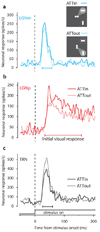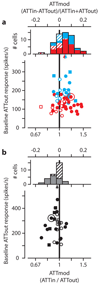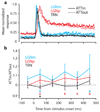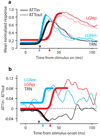Guarding the gateway to cortex with attention in visual thalamus
- PMID: 18849967
- PMCID: PMC2713033
- DOI: 10.1038/nature07382
Guarding the gateway to cortex with attention in visual thalamus
Abstract
The massive visual input from the eye to the brain requires selective processing of some visual information at the expense of other information, a process referred to as visual attention. Increases in the responses of visual neurons with attention have been extensively studied along the visual processing streams in monkey cerebral cortex, from primary visual areas to parietal and frontal cortex. Here we show, by recording neurons in attending macaque monkeys (Macaca mulatta), that attention modulates visual signals before they even reach cortex by increasing responses of both magnocellular and parvocellular neurons in the first relay between retina and cortex, the lateral geniculate nucleus (LGN). At the same time, attention decreases neuronal responses in the adjacent thalamic reticular nucleus (TRN). Crick argued for such modulation of the LGN by observing that it is inhibited by the TRN, and suggested that "if the thalamus is the gateway to the cortex, the reticular complex might be described as the guardian of the gateway", a reciprocal relationship we now show to be more than just hypothesis. The reciprocal modulation in LGN and TRN appears only during the initial visual response, but the modulation of LGN reappears later in the response, suggesting separate early and late sources of attentional modulation in LGN.
Figures




References
-
- Desimone R, Duncan J. Neural mechanisms of selective visual attention. Annu Rev Neurosci. 1995;18:193–222. - PubMed
-
- McAdams CJ, Maunsell JH. Effects of attention on the reliability of individual neurons in monkey visual cortex. Neuron. 1999;23:765–773. - PubMed
-
- Reynolds JH, Chelazzi L. Attentional modulation of visual processing. Annu Rev Neurosci. 2004;27:611–647. - PubMed
Publication types
MeSH terms
Grants and funding
LinkOut - more resources
Full Text Sources
Other Literature Sources

